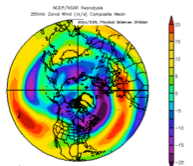This work is inspired by the Lorenz-1984 model, and looks into hemispheric surface temperature gradients as diagnostic indicators of mid-latitude atmospheric circulation dynamics. The relationship between hemispheric temperature gradients, ENSO, and the location and strength of the Northern Hemisphere jet stream and storms is investigated in reanalysis and GCMs.

Paper:
-- C.Karamperidou, F. Cioffi, and U. Lall. ”Surface Temperature Gradients as Diagnostic Indicators of Midlatitude Circulation Dynamics”, J. Climate, doi: 10.1175/JCLI- D-11-00067.1.
Posters:
-- A Reduced-Variable View of GCM Projections of Midlatitude Storms , AMS 92nd Annual Meeting, N. Orleans, 22-26 Jan 2012.
-- C.Karamperidou, U.Lall, F.Cioffi. Northern Hemisphere Meridional and Zonal Temperature Gradients and their Relation to Hydrologic Extremes at Mid-latitudes: Trends, Variability and Link to Climate Modes in Observations and Simulations., AGU Fall Meeting 2010.
-- C.Karamperidou, F. Cioffi & U. Lall. Surface Temperature Gradients and their Relation to Mid-latitude Circulation Dynamics and Inter-annual Precipitation Variability: Trends and Links to ENSO in Observations and Low-order Models, EGU General Assembly 2011.
-- "Insights from a Low Order Model of Increasing Complexity: Probability and Temporal Structure of Climate Extremes", AGU Fall Meeting 2009.
-- "Projections of Climate Extremes under Potential Climate Change as Represented by Changing Equator-to-Pole Temperature Gradient and Ocean-Land Temperature Contrast", AGU Fall Meeting 2009.